I see so many guys who dress to the nines but fail when correctly pairing their shirt collar design with the rest of their outfit. No big deal, right?
Wrong – wearing the wrong collar can ruin your entire outfit (especially if you're wearing a tie!) The different structures, shapes, and designs make a huge difference in how your shirt looks.
As ever, it's my job to make sure you guys put your best foot forward. In today's article, I'm laying out the ground rules to help you understand the dos and don'ts of men's shirt collars.
We'll be covering:
- Quick Shirt Collar History
- Men's Shirt Collar Overview
- Choosing the Best Collar For You
- Popular Men's Collar Types
#1 Shirt Collar History
Why Men Started To Wear Shirt Collars

The first men's shirt collar design appeared in the mid-1400s. Before this, men wore tonics with a boat neckline or scoop neckline. These collars were huge and could stand up on their own, and were at the peak of their popularity during the 16th-century.
Early “Neck Ruff” collars were seen as a status symbol for the elite members of society. Many portraits of this era feature this type of collar.
Detachable Shirt Collars
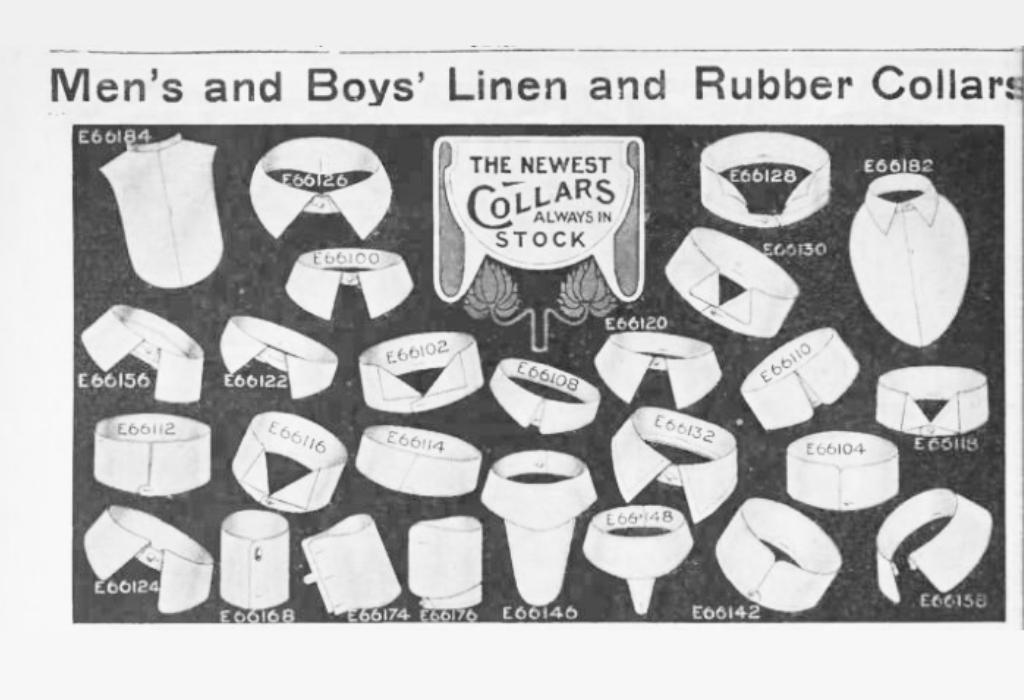
Collars and cuffs were the most visible parts of the shirt during the 19th Century. As such, they were the most likely part to get dirty. To avoid doing huge amounts of laundry, detachable collars were invented.
This would allow men to clean the collars of their shirts without washing the rest of the garment. A helpful feature, as modern laundry technology was not yet invented. These collars were excessively starched and shaped in many different ways.
During this era of men's shirt collars (the mid to late 1800s), the various dress shirt collar design we know today started to develop.
Lighter Fabrics and The Polo Shirt
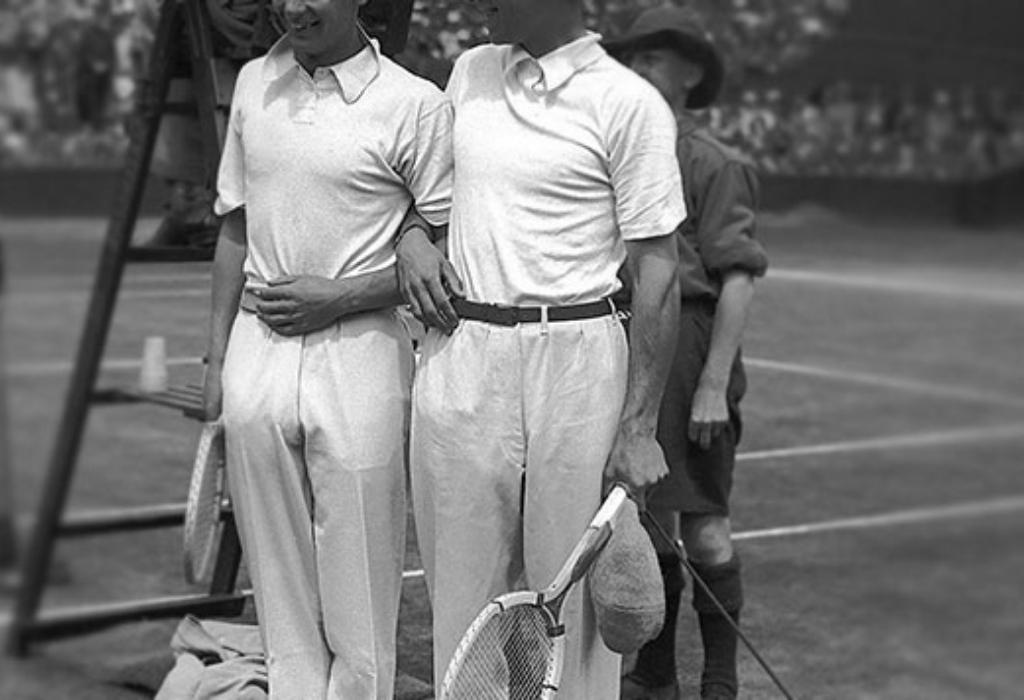
A detachable shirt collar design with extreme starch began to fade in popularity in the 1920s and 1930s. With the invention of central heating and other luxuries, men began to look for clothing with lighter fabrics.
Men found that soft collared shirts could be wrinkle-free without the extra starch by ironing them. This would allow men to wear lighter fabrics, and shirts made out of linen and lightweight cotton became the standard.
With the advent of soft collars, the invention of the polo shirt by Rene Lacoste was in 1933. The name “polo shirt” was inspired by Lacoste's polo-playing friend, who gave him the idea for the iconic shirt.
White Collar vs. Blue Collar
It was around the same time that lighter fabrics came into fashion when the vernacular of White Collar & Blue Collar began.
This distinction originated because of laundry issues. Men at desk jobs could keep their white shirts clean, but men with manual labor jobs favored the dark fabric colors that could hide dirt more easily.
Today, this kind of distinction is still made. However, men in a modern office can wear blue shirts without being accused of dressing inappropriately. The lines have been blurred between strictly wearing a white or blue-collar based on your job.
This article is sponsored by Slick Collar – the first adjustable shirt collar support solution. Tired of your collar wilting by the end of the day? Then you're in luck – Slick Collar's simple design supports the collar and helps keep it standing upright all day long.
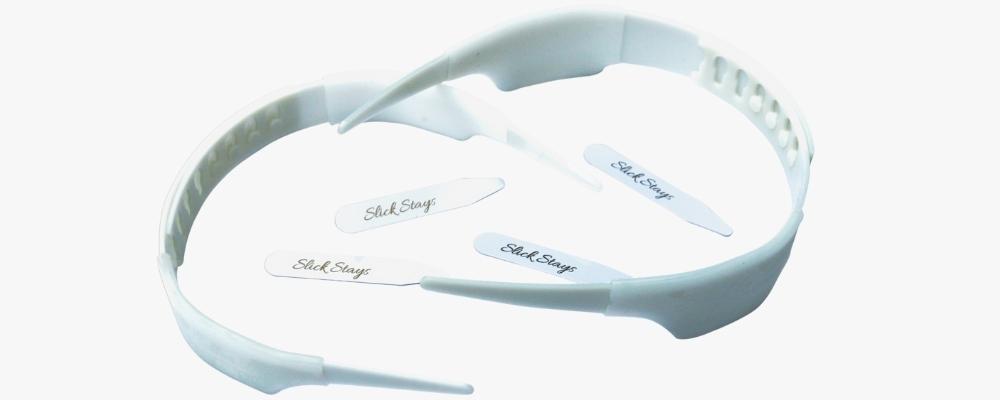
The Slick Collar Shirt Collar Support Bundle set includes The Original Slick Collar and Slick Collar Slim, 4 premium quality shirt collar stays.
Slick Collar is offering you an exclusive promotion for a limited time! Click here and enter the code “RMRSUMMER” at checkout for a great deal on Slick Collar today!
#2 Men's Shirt Collar Overview
What Are The Parts Of The Shirt Collar?
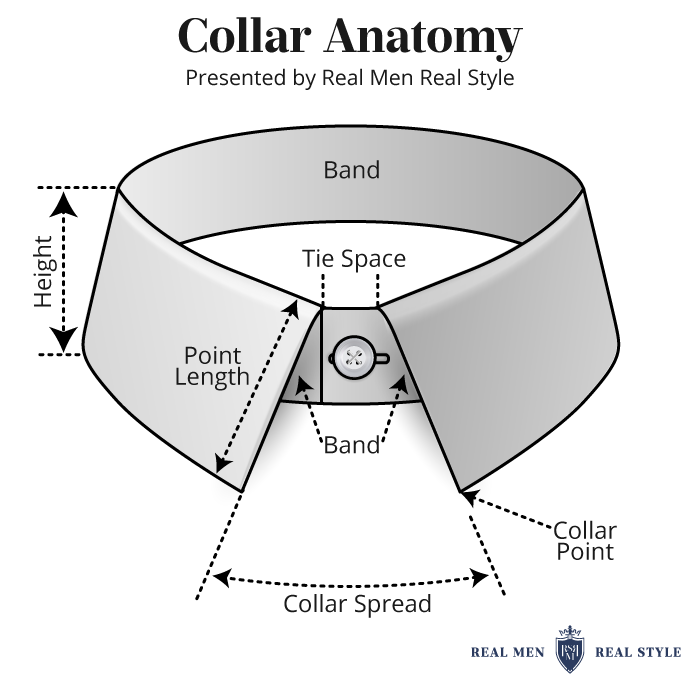
- Collar Points – The tips of the collar.
- Collar Point Length – The distance from the Collar Points to where they meet the Collar Band.
- CollarBand – The piece of fabric that wraps around the neck.
- Collar Height – The height of a folded collar as it fits on the neck.
- Tie Space – The distance between the top of the folded collar parts where the shirt is buttoned.
- Collar Spread – The angle between Collar Points.
Collar Stays
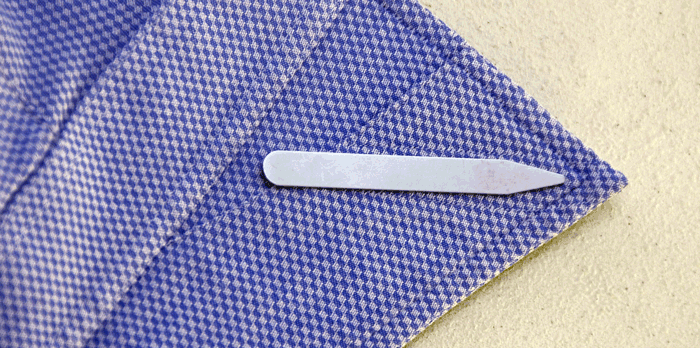
Also called “Collar Tabs” or “Collar Stiffeners,” Collar Stays are flat, rigid pieces of material inserted in special pockets on the underside of both collar points. They can be removable or sewn in.
Collar Stays can be made of plastic, stainless steel, brass, and gold, among other materials. Some even feature magnets to hold the collar in place even more.
How is a Shirt Collar Constructed?
Most shirt collar designs are constructed with what is called a Collar Stand. A Collar Stand is a frame that makes the collar stand up and is why most shirt collars feel thicker than the rest of the shirt.
The Collar Stand can either be separate or integrated into the collar construction. Most integrated stands are used for thin shirt collars such as polo shirts or casual button-down collar shirts.
Some shirt collars have a separate Collar Stand that sits closer to the neck than the integrated collar stand. A separate frame is found in most dress shirts and military uniforms as it gives the collar more height, thickness, and lift.
What is the Correct Shirt Collar Fit?
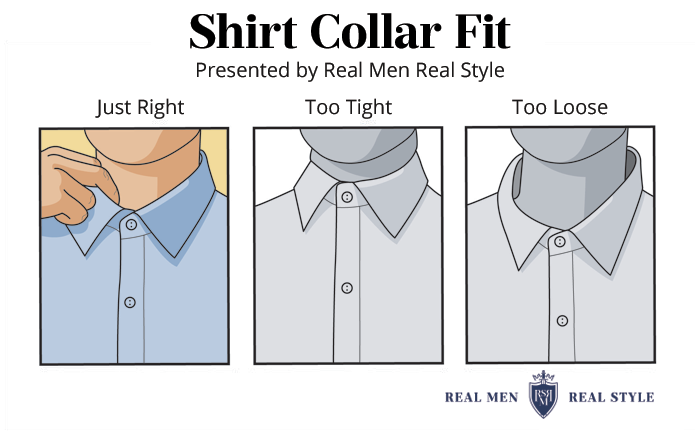
For the perfect shirt collar fit, two fingers should be able to slide comfortably between the neck and collar of a shirt with the top button closed. It is essential to nail the fit as it can be painful to get it wrong.
Collar Fabric & Materials
Most collars are made of the same material as the rest of the shirt. The thickness of the collar comes from the construction, as previously mentioned.
Sometimes shirt collars can be made with a different fabric to add a flair, such as the popular contrasting collar and cuff style, which Michael Douglas popularized in the classic film, Wall Street.
Soft Collar Vs. Stiff Collar
The softer a collar, the more casual it is. The stiffer a collar is, the more formal it is. There are exceptions, but this is a good rule to follow when picking shirt collars.
#3 Choosing the Best Shirt Collar for Your Face
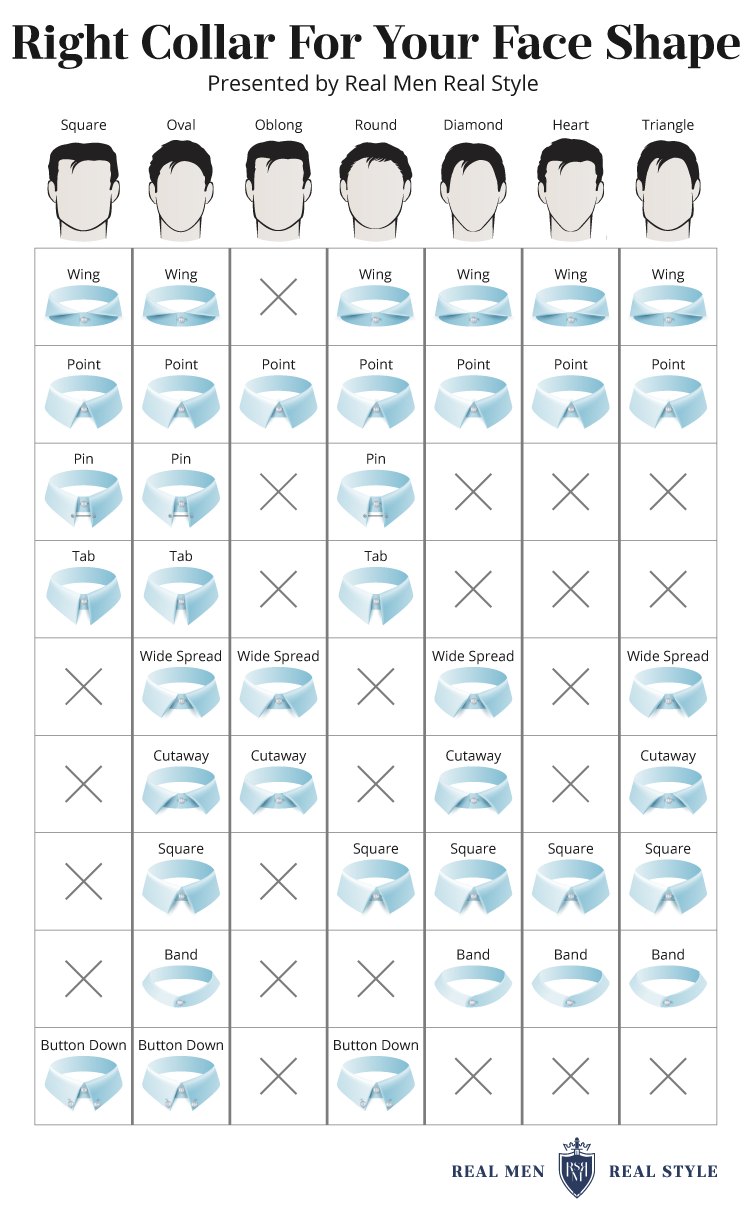
When choosing the best shirt collar design, you must consider both the size of your face and its shape.
It is also important to remember that you can wear any shirt collar design you want to; however, some shirt collar types may suit you better than others.
For instance, if you have a round face, it would be wise to choose a point collar to balance this out more. On the other hand, choose a spread or cutaway collar if you have an oblong face.
#4 Popular Men's Collars
Classic Point Collar
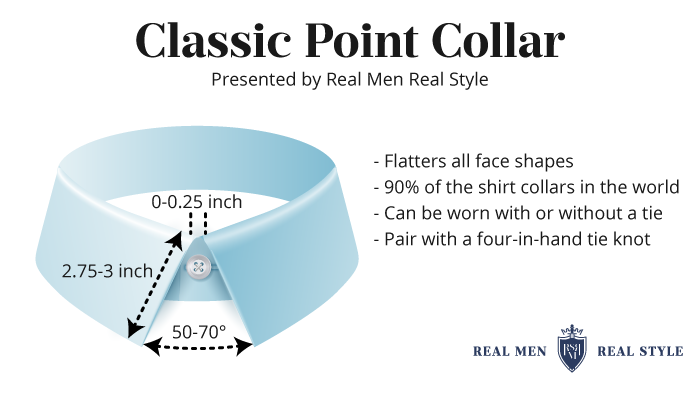
Of all dress shirt collar designs, the Point Collar is probably the one you are most familiar with, as it makes up around 90% of the dress shirt collar types worldwide. With an average collar spread of 1 inch to 3 inches or 50-70 degrees, the Point Collar works well with a necktie or without.
This style also typically has a Collar Height of 1-2 inches and a collar point of 2-3 inches in length. Manufacturers use this collar type for most shirts because it will appease the majority of wearers.
The Point Collar is best for men with a wide or round face — however, most facial shapes and sizes are flattered with this collar style.
When worn with a jacket, the collar points will not be covered by the lapels. This collar also won't show any part of your tie other than the knot as the spread is so small.
Wide Spread Collar
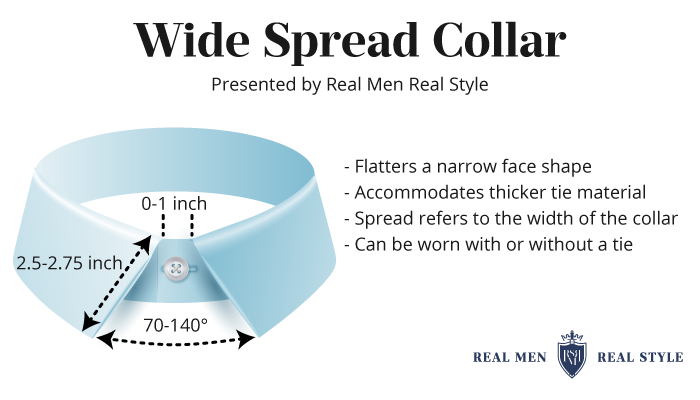
Just as the name states, The Wide Spread shirt collar design is a collar that has a broader collar spread.
Typically, the spread is anywhere from 4 inches to 6 inches between the collar points with an average point angle of between 45 degrees and 60 degrees.
This collar is a popular option when wearing wider tie knots like the Windsor and Half-Windsor. A Wide Spread Collar will also allow you to wear ties made with thicker material such as wool.
This collar is best suited for a man with thin or long facial features. Men with round faces should try to avoid these collars as they will make their faces look even more round.
Cutaway Collar
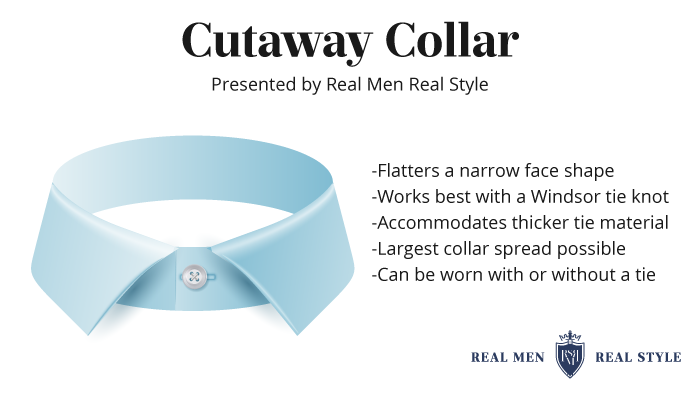
The Cutaway Collar is a spread collar with an extremely wide distance between the Collar Points.
A distance over six inches between Collar Points qualify as a Cutaway Collar. Sometimes this collar can even have a 180-degree angle, forming a straight horizontal line.
The cutaway shirt collar design is a favorite in Italian tailoring and requires a large tie knot if you wear a tie. However, this style works best without a tie with the top button or two open.
Button-Down Point Collar

A much more casual option, the Button-Down Point Collar has a rich history in menswear.
Initially worn by English polo players, Brooks Brothers brought this European style to the United States, quickly becoming a favorite.
This style features buttonholes at the very tip of each Collar Point, corresponding to a small button on each side of the shirt front. This shirt is the least formal collar choice.
Even though some European fans of Sprezzatura wear this collar with the collar point buttons open to project confidence and nonchalance, I recommend always having the collar point buttons fastened.
The nice thing about the Button-Down Point Collar is that it is suitable for any face shape, making it highly versatile.
Pin Collar
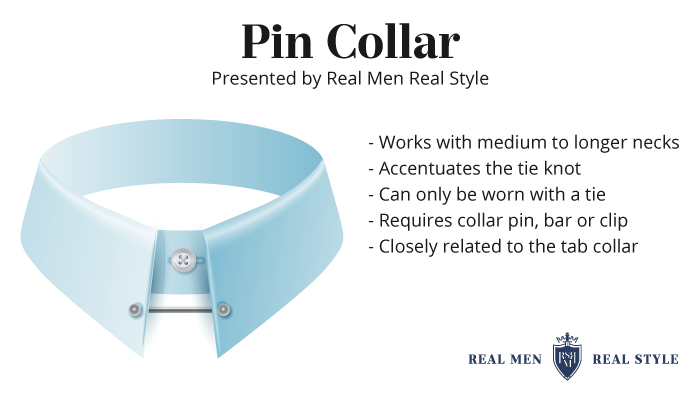
The Pin Collar has small holes in each point, which allows the insertion of a pin or bar placed behind the tie – which thrusts the tie forward and puts more emphasis on your tie knot.
Pin Collars must be worn with a tie as the empty holes, and flapping tabs would present an untidy appearance.
Today, Dandies favor this collar, and most have the confidence to pull it off. Pins, Bars, and Clips can all be used for the holes in the Pin Collar. These should be matched to any other metals you wear, such as a wristwatch or metal band.
It has fallen out of popularity due to the “fussy” nature of the collar, which most men do not want to deal with.
Tab Collar
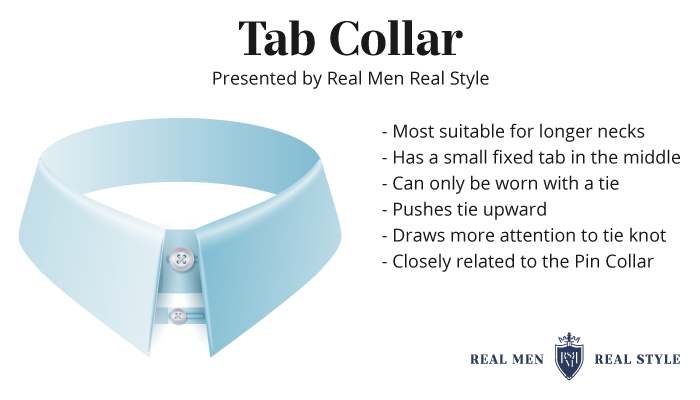
A cousin to the Pin Collar, Tab Collars are a vintage collar option and one that has been having a bit of a resurgence in recent times.
This unique collar features a tab across the middle, which attaches to the top button with a hook-and-loop closure that sits behind your tie. This forces the tie forward and up, creating a “standing” look for the tie.
Because of the tab, you cannot wear this collar without a tie. Tab Collars flatter men with longer necks the most. The higher stance of the tie knot helps to diminish a long neck.
Tab Collars have been popping up more and more today, with the most notable wearer being Daniel Craig as James Bond in both Skyfall and No Time To Die.
Wing Collar
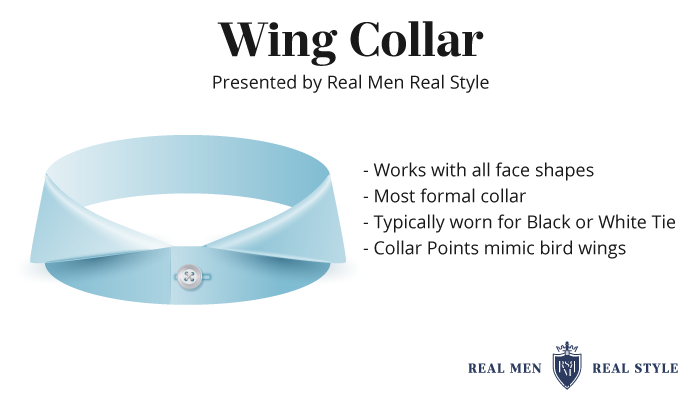
Reserved for highly formal events, the Wing Collar is a minimalist collar that was very popular in the early 20th Century.
“Wingtip” or “Winged” are alternative names for a Wing Collar. This is because the small tips resemble the open wings of a bird.
You can wear a Wing Collar with a standard necktie or bow tie, but the latter is more common. Most men wear this collar for a vintage look in either black or white-tie situations.
Worn mainly in the service industry (butlers/valets/waiters, this collar flatters a narrow face the most.
Club Collar
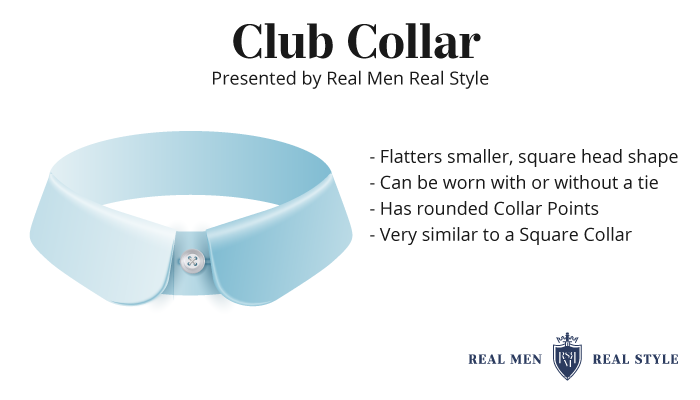
The Club Collar has a narrow spread and vintage appearance.
Students at Eton College created this collar for their uniforms as young students were looking for a way to stand out and show that they attended Eton.
The round nature of this collar makes it perfect for a smaller face. If worn with a larger head, a Club Collar will make your head look much larger than it is.
Square Collar
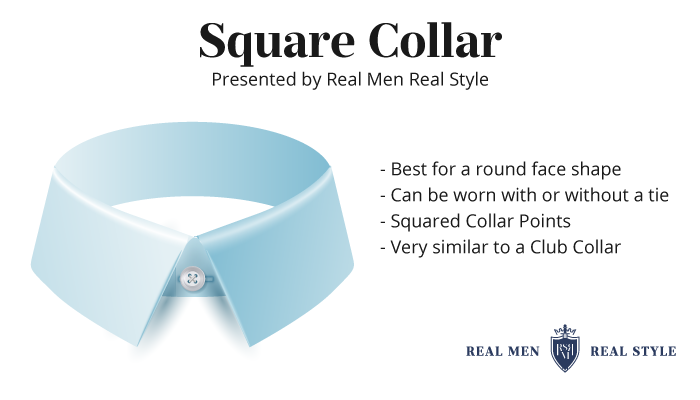
Closely related to the Club Collar, the Square Collar is another collar from the early 20th Century.
A Square Collar has a very minimal spread. The title of “Square” comes from the squared-off collar points.
These were typically worn in detachable form but are hard to find. Most of the time, private school children in England wear this collar type.
Band Collar
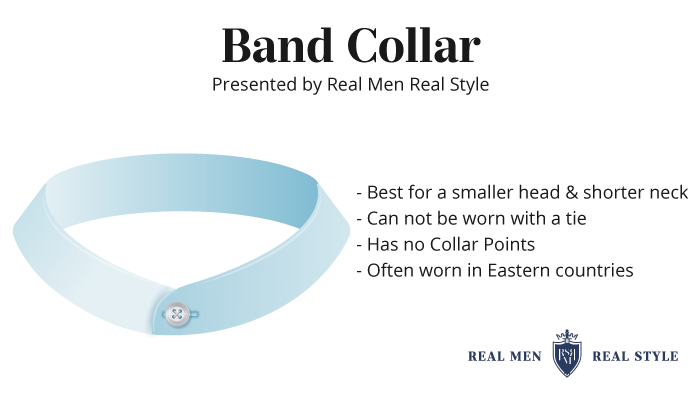
Found in many Eastern Cultures, the Band Collar is a bold choice for any man.
The Band Collar is the most unique dress shirt collar type as some do not even consider it a shirt collar! This collar must be worn tieless and is challenging to pull off, but a man with a shorter neck could wear it without much trouble.
If worn by a man with a long next, the Band Collar would look extremely strange and out of place. Mandarin jackets also feature this collar style.
Doctor Evil wore this collar famously in the spy spoof series Austin Powers. Many contemporary musical conductors and maestros wear this style jacket with a standard point collar underneath.
Now that you know what dress shirt collar type is right for you, click here to check out my guide on matching your tie to your suit and shirt, or check out the video below.
The post Dress Shirt Collar Types For Men | Ultimate Guide to Shirt Collars appeared first on Real Men Real Style.

0 Commentaires